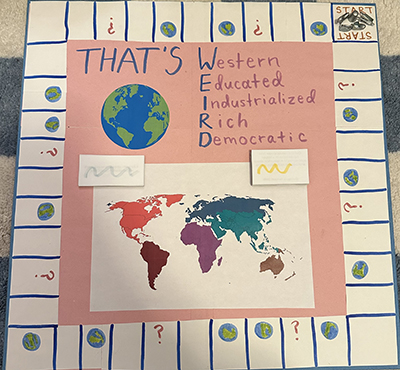
We’ve all heard the concerns about technology and teens: Cellphones shorten attention spans. Video games replace healthier pastimes. Social media breeds FOMO — a fear of missing out. But are the concerns warranted?
Lucía Magis-Weinberg, assistant professor of psychology in the UW College of Arts & Sciences, studies the impact of digital technology on adolescent development and recently created a new course to explore these questions. The course, PSYCH 448E: Digital Technology and Youth, was offered for the first time Autumn Quarter 2023, with 28 students enrolled.
The class explores the impact of digital media on adolescent development, covering topics such as the developing brain, identity development, depression and anxiety, attention problems, and body image. Magis-Weinberg also covers cyberbullying and ways to reduce digital distraction. If the course topics suggest that all aspects of digital technology are problematic for youth, Magis-Weinberg is quick to dispel that notion.
“We like to blame everything on social media,” she says. “It has become a scapegoat for so many problems. But it’s more nuanced than that. It is just one of the many players in adolescent development, and it offers both risks and opportunities.”
Imagine the Adolescent Brain as a Sports Car...
As a doctoral student, Magis-Weinberg focused on adolescent brain development related to memory and decision-making. Her interest in digital technology and youth came soon after, inspired by conversations with parents and teachers concerned about how a rise in social media was affecting teens.
“That was around 2012,” Magis-Weinberg recalls. “Facebook was really gaining traction by then. The concerns of parents and teachers planted a seed for me, a realization of how important this was becoming as a new context in which adolescents are interacting and learning and having issues.”

Magis-Weinberg’s research focuses on online spaces where youth interact with one another — social media platforms, video games, YouTube — with the specific characteristics of adolescence in mind. She notes that teens are particularly concerned with how popular they are and what their friends think of them. This has always been the case, but with the emergence of social media, such information is now ever-present. Popularity is no longer an abstraction; it can be measured by the number of “likes” on an Instagram post, visible to all.
On top of that, the adolescent brain is still developing. Magis-Weinberg likens it to a sports car with a responsive accelerator but a less responsive brake. The accelerator — the brain’s limbic system — responds to things that are exciting and rewarding. In teens, that’s often social interactions that bring status and popularity. The brake — the brain’s cognitive control system — regulates impulses by considering long-term consequences.
“We know from research that the accelerator of the car matures much earlier than the brake of the car,” Magis-Weinberg says. “The accelerator is very active by the age of 15 or 16. The brake continues to mature until about age 25. Combine that with a thrilling social media environment that is giving them social opportunities, rewards, and novelty all the time, and it’s clear why social media uniquely appeals to the adolescent brain.”
A Digital Record of Every Mistake
The course delves into the many ways that digital media impacts teens, both negative and positive. One area of focus is identity development. Adolescence is a time for youth to figure out their identities — what activities they enjoy, where they excel, who they are attracted to. With digital technology, all that exploring is on public display and remains forever accessible online.

“Adolescence is a time of learning and exploration, and sometimes that means making mistakes,” Magis-Weinberg says. “It always has been. But now, as people are navigating identities, learning, exploring new things, making those mistakes, everything is permanently recorded.”
Still, some teens find digital technology invaluable when it comes to identity development. Youth struggling to find a community that shares their identity — LGBTQ teens in rural areas, for example — may find that community on social media, which can lead to a positive and meaningful impact and support.
There is no such upside when it comes to body image and digital technology. As teens grow into their developing bodies, it is natural that they are preoccupied with looks and body standards. Their mirrors are now digital, reflecting not only themselves but often a deluge of visual content, fashion, and impossible beauty standards, which poses a risk for the development of body-image issues. Many adolescents don’t realize that influencers manipulate their photos to erase any flaws.
There are a lot of positive aspects to social media and technology, but the people working directly with youth or designing these platforms need to be mindful of adolescents’ particular needs.
“We blame social media for a lot of problems where the evidence is not strong,” says Magis-Weinberg, “but one of the areas where we do see strong evidence that social media is damaging is body image. Social media has been shown to increase the risk of developing body-image concerns and then eating disorders tied to that. That topic really resonated with the students. A lot of them spoke about how overwhelming beauty, diet and exercise content can be on social media.”
Sharing the Message with Teens
The students had an opportunity to educate their younger selves about such issues — figuratively, of course — with their final course project. Throughout the quarter, they prepared class presentations on specific aspects of digital technology and youth, highlighting recent research. For their final project, they reframed the same information for a teen audience using creative ways to deliver their messages.

Rachel Singh (BA, Psychology, December 2023) created a lesson plan, tailored for middle school students, about sexual development and digital media. “I tried to incorporate what I would have wanted to hear at that age, while still acknowledging that it’s an uncomfortable topic,” she says.
Anna Ergeson (BS, Psychology, December 2023) created a board game, “That’s Weird,” to educate teens about global digital media trends. “The game’s title comes from the idea that the vast majority of psychological studies center WEIRD (Western, Educated, Industrialized, Rich, and Democratic) populations,” Ergeson explains. “I wanted adolescents to learn about important studies happening outside of the Western world, in a way that was more engaging than an essay or infographic and that allowed them to play a part in their own learning.”
Magis-Weinberg was impressed by the final projects and hopes the course will help inform her students’ future work, in fields ranging from clinical psychology to digital technology.
“Many of my students will go on to work with teens as clinicians, teachers, and researchers,” she says. “Other students are hoping to work inside tech companies. There are a lot of positive aspects to social media and technology, but the people working directly with youth or designing these platforms need to be mindful of adolescents’ particular needs. I hope my course helps with giving them a nuanced understanding of adolescent development in the digital age.”
More Stories

Two Majors, Complementary Skills
Elizabeth Xiong (2024), a double major in art history and computer science, shares how she gained different and complementary skills from each major.

Exploring Connections Through Global Literary Studies
The UW's new Global Literary Studies major encourages students to explore literary traditions from around the globe and all eras of human history.

What the Sky Teaches Us
Brittany Kamai, an astrophysicist with knowledge of Pacific Islanders' Indigenous navigation using the sky, is teaching a new UW course, Pacific Indigenous Astrophysics.
